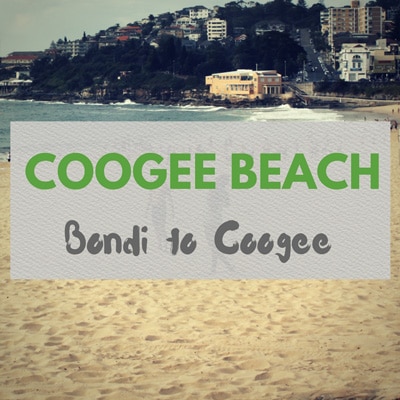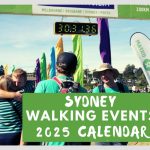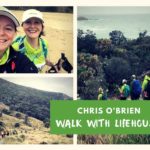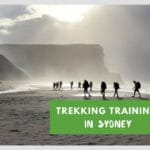Coogee Beach is Stop 1 on the Bondi to Coogee Walk as marked on the Coogee to Bondi Walk Map.
The Biddabiddigal mob of the Dharuk nation lived here for at least 8500 years before the first Europeans arrived. They knew Coogee as Kuji, which means “bad smell” or “stinking” due to the decaying seaweed that washes ashore.
They fished from bark canoes, nuwi, in the bay, harvested oysters, badangi, from rock ledges at either end of the beach and hunted swamp wallaby, banggarai, in the scrub that ran to the sand’s edge.
Wedding Cake Island is in the middle of the bay. So named for its appearance when it’s awash with foam in a big swell. If you’re a keen swimmer it’s a 2.4km circuit around the island from the beach. Nearly 2,000 swimmers compete in the the annual Coogee Island Challenge in November, swimming this circuit.
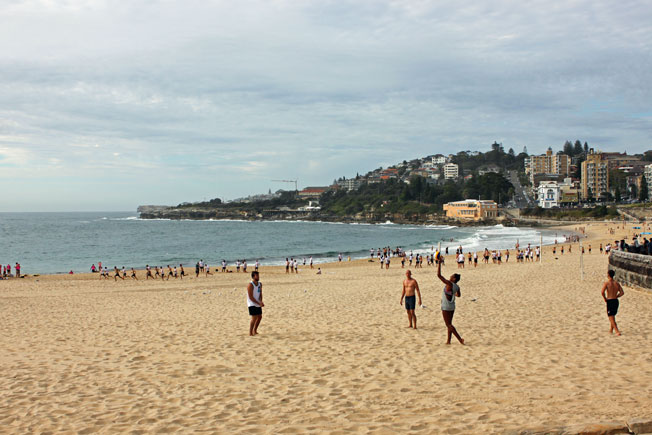
It’s fitting that Australia’s first two female Olympic swimmers came from Coogee. Fanny Durack and Wilhelmina Wylie won gold and silver respectively in the 100m freestyle at Stockholm Olympics in 1912. This was the first time female swimming was included in the Games. They were lucky to go at all as authorities claimed there was only enough money to send men. Following a public outcry, the rule was relaxed.
Fanny Durack held every female swimming world record from 100 yards to 1 mile. She is buried in Waverley Cemetery, further along this walk. Wylie’s Baths, the large ocean pool and platform around the corner at the southern end of Coogee beach was built by Wilhelmina’s father, Henry in 1907.
At the northern of end of Coogee Beach, just before you reach the cafe strip, you might see the remains of some timber piers in the water. Coogee Pier opened in 1928 and stretched 180 meters out to sea from the beach. Try and visualise an elevated platform stretching for nearly two football fields into the surf. That’s almost the distance to Dolphin Point.
Coogee Pier housed a 1,400 seat theatre, a ballroom with capacity for 600 people and a 400 seat restaurant. Completing the English view of seaside entertainment was a penny arcade and various small shops. Unfortunately – or fortunately depending on your view of famous English piers like Brighton and Blackpool – Coogee's pier was damaged by rough surf and demolished in 1934.
You’ll pass Coogee Pavilion on your left, just before you turn right out to Dolphins Point. This is the site of the old Coogee Palace Aquarium, where, in 1935 a Tiger shark swimming in the aquarium regurgitated a tattooed human arm. The arm had been severed with a sharp blade before being swallowed by the shark, prompting a murder investigation.
It belonged to Jim Smith, a colourful character with links to the underworld who had been missing, presumed murdered. Despite a police investigation and court case, the person responsible for removing the arm was never discovered. Jim Smith’s torso was never recovered.
Stop 1: Coogee Beach – you are currently on this page
Stop 2: Shrine to Virgin Mary
Stop 3: Bali Memorial
Stop 4: Dunningham Reserve Sandstone Cliffs
Stop 5: Gordons Bay
Stop 6: Gordons Bay Underwater Nature Trail – this page is on its way
Stop 7: Clovelly – this page is on its way
Stop 8: Waverley Cemetery – this page is on its way
Stop 9: Bronte Beach – this page is on its way
Stop 10: Bronte SLSC – this page is on its way
Stop 11: Tamarama – this page is on its way
Stop 12: Aboriginal engraving site – this page is on its way
Stop 13: Mackenzies Point – this page is on its way
Stop 14: Monument to Black Sunday – this page is on its way
Stop 15: Bondi SLSC – this page is on its way

